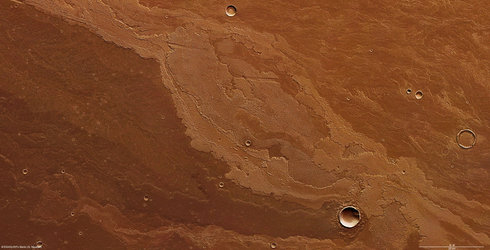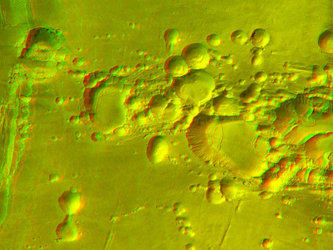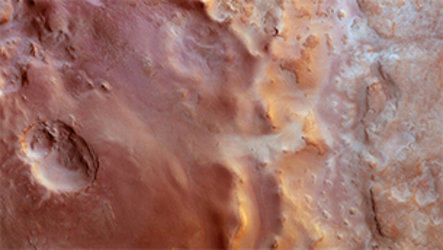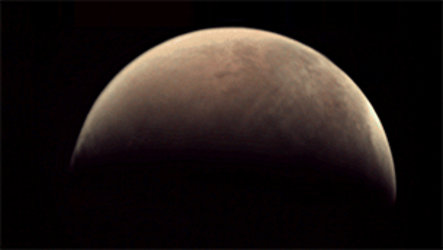Lava floods the ancient plains of Mars
Two distinct volcanic eruptions have flooded this area of Daedalia Planum with lava, flowing around an elevated fragment of ancient terrain.

The images were acquired by ESA’s Mars Express on 28 November 2013 towards the eastern boundary of the gigantic Tharsis Montes volcanic region, where the largest volcanoes on Mars are found.
The lava flows seen in this image come from Arsia Mons, the southernmost volcano in the Tharsis complex, which lies around 1000 km to the northwest of the region featured here.
This volcanic region is thought to have been active until tens of millions of years ago, relatively recent on the planet’s geological timescale that spans 4.6 billion years.
The rough elevated terrain at the bottom of the main image is imprinted with three distinct but eroded impact craters, the largest of which is about 16.5 km wide and named Mistretta. The ancient foundation it sits on once belonged to the vast southern highlands, but is now surrounded by a sea of lava, like many other isolated fragments that can be seen in the wider context image.

Lava flows from two distinct eruptions have reached the foot of this particular feature.
The first eruption produced the lava flow to the south of the island (to the left in the main image and to the right in the close-up perspective image). This flow subsequently experienced extensive faulting due to tectonic forces, resulting in the numerous trough systems.
The younger lava flow (right in the main image, left in the close-up image) must have taken place after the tectonic event that caused the faulting because it overlies both the older lava surface and the tectonic features. Indeed, at the front of the flow, several tongues of lava have flowed preferentially along the lower ground of the troughs.

Another clear indication of the relative ages of the two flows is given by the impact craters: the older, fractured lava flow has more and larger ones than the younger flow.
The younger lava flow also has a rough texture, with many small ridges on the surface. These features form as result of speed gradients within the lava flow due to the difference in temperature between the hot, faster-flowing interior lava and the cooler, slower ‘roof’ of the flow that is exposed to the atmosphere.
But neither lava flow travelled unimpeded. The highland ‘island’ in this scene created an obstacle, forcing them to circle its flanks and override its base, most noticeable to the north (to the right in the main colour, topography, and 3D images).

The wider Daedalia Planum region bears witness to numerous lava flows similar to these, each one overlaying the last. By carefully studying the boundaries between overlapping flows, planetary scientists can build up a picture of the eruption history of the Red Planet’s giant volcanoes.















 Germany
Germany
 Austria
Austria
 Belgium
Belgium
 Denmark
Denmark
 Spain
Spain
 Estonia
Estonia
 Finland
Finland
 France
France
 Greece
Greece
 Hungary
Hungary
 Ireland
Ireland
 Italy
Italy
 Luxembourg
Luxembourg
 Norway
Norway
 The Netherlands
The Netherlands
 Poland
Poland
 Portugal
Portugal
 Czechia
Czechia
 Romania
Romania
 United Kingdom
United Kingdom
 Slovenia
Slovenia
 Sweden
Sweden
 Switzerland
Switzerland



































